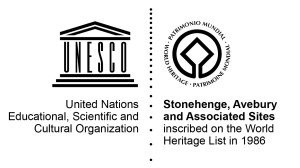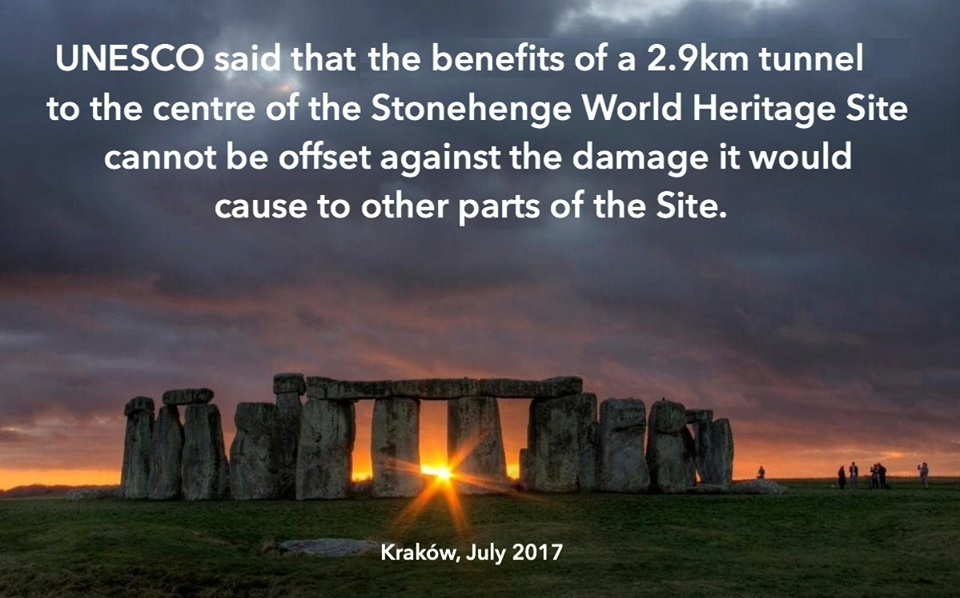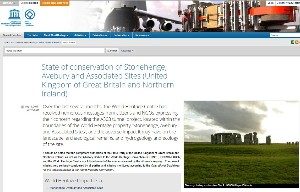What is a UNESCO World Heritage Site?
“World Heritage is our legacy from the past, what we live with today, and what we pass on to future generations. What makes the concept of World Heritage exceptional is its universal application. World Heritage Sites belong to all the peoples of the world, irrespective of the territory on which they are located.”
 Stonehenge, Avebury and Associated Sites World Heritage Site
Stonehenge, Avebury and Associated Sites World Heritage Site
In 1986, Stonehenge was designated by UNESCO, together with Avebury and Associated Sites such as Silbury and West Kennet Long Barrow known as the “Stonehenge, Avebury and Associated Sites World Heritage Site”. The description of the World Heritage Site (WHS) includes a Statement of Outstanding Universal Value (OUV) which explains why the WHS is considered to be of such importance to mankind.
The UK Government is signatory to the 1972 World Heritage Convention. Article 4 of the Convention states that:
“Each State Party to this Convention recognizes that the duty of ensuring the identification, protection, conservation, presentation and transmission to future generations of the cultural and natural heritage referred to in Articles 1 and 2 and situated on its territory, belongs primarily to that State. It will do all it can to this end, to the utmost of its own resources and, where appropriate, with any international assistance and co-operation, in particular, financial, artistic, scientific and technical, which it may be able to obtain.”
UNESCO requires State Parties to the Convention to produce management plans for their WHSs. Until 2015, Stonehenge and Avebury had separate management plans but a joint management plan for the whole WHS has been published. The new Management Plan includes a set of maps showing different aspects and characteristics of the WHS.
UNESCO & Stonehenge WHS Reports and Decisions
2024
21 – 31 July – UNESCO’s World Heritage Committee, Delhi
24 June – World Heritage Centre draft Agenda in which it is recommended that the World Heritage Committee agree to place Stonehenge and Avebury World Heritage Site on the List of World Heritage in Danger, having repeatedly requested that the cuttings be removed from within the inscribed property which would cause a major negative impact on the overall prehistoric landscape. Recommendations published on page 10 onwards here.
1 February – Only the summary of the State of Conservation Report by UK Government has been published. The full report has been requested by the Stonehenge Alliance has been suppressed.
2023
10-25 September – At the World Heritage Committee (WHC) held its 45th Extended Session in Riyadh and expressed disappointment that the UK Government approved the short tunnel scheme, and agreed to would place Stonehenge on the List of World Heritage in Danger if the scheme were to go ahead. The WHC requested that the UK Government report to the WHC in February 2024. Here is the WHC decision.
2022
June/July – The World Heritage Committee meeting which was due to take place in Russia was postponed due to the war in Ukraine. A new date and host is awaited.
April 2022 – The Advisory Mission report (April 2022) said that ideally the road should be taken outside the WHS, but stated that any tunnel should extend at least to the western WHS boundary. However, no decision should be taken on the scheme before the next World Heritage Committee meeting.
2021
The postponed and extended 44th session of the World Heritage Committee was held from 16 to 31 July. The Committee maintained its position concerning the A303 Stonehenge scheme and confirmed, in its Decision of 22 July that, should the High Court allow the scheme to proceed and it is not modified, consideration would be given to placing Stonehenge, Avebury and Associated Sites World Heritage Site on the List of World Heritage Sites In Danger at its next meeting in 2022.
2020
The 44th session of the World Heritage Committee, initially scheduled for 29 June/9 July 2020 was postponed due to the pandemic. It was agreed that an extended session would be held in June/July 2021.
2019
The report and draft decision were agreed at the 43rd Session of the World Heritage Committee at Baku, Azerbaijan, on 4 July and can be found on page 203 of Item 7B of the Provisional Agenda – Provisional Agenda – State of Conservation of Properties.
The Decision was adopted unchanged by the World Heritage Committee, which states that the Committee:
“Notes with concern that although the current scheme, which is now subject to the Development Consent Order (DCO) examination process, shows improvement compared with previous plans, it retains substantial exposed dual carriageway sections, particularly those at the western end of the property, which would impact adversely on the Outstanding Universal Value (OUV) of the property, especially its integrity, and therefore encourages the State Party to not proceed with the A303 route upgrade for the section Amesbury to Berwick Down in its current form”.

The wording on this image has been taken from the Report of UNESCO’s World Heritage Centre and advisory bodies to the WHCommittee in 2017 (Krakow). See https://whc.unesco.org/en/soc/3652/.
2018
- The World Heritage Committee noted the concerns of the Mission report and urged the Government to explore ways of avoiding impact on the OUV of the WHS. Read WH Committee Decision 2018 in full.
- Stonehenge, UNESCO and the Spanish amendments: Our blog about our statement to the WH Committee and its decision-making.
- Mission report concluded that if the current length of the tunnel is pursued the damage inflicted by the dual carriageway cuttings would impact adversely on the integrity and Outstanding Universal Value (OUV) of the Stonehenge WHS. Report here.
- The UNESCO/ICOMOS Mission interviewed stakeholders including The Stonehenge Alliance in March 2018.
2017
- Report of the World Heritage Committee and its decision in July in Krakow: Please scroll down to view the report and decision at the bottom of this page.
- Report to the joint World Heritage Centre/ICOMOS Advisory mission to Stonehenge, Avebury and Associated sites (UK), 31 January – 3 February 2017 presented to the UK Government in June 2017.
- Our blog about the World Heritage Committee Meeting here.
 Blog: “World Heritage Site: A status worth fighting for?”
Blog: “World Heritage Site: A status worth fighting for?”
Founded in 1945, UNESCO was founded in 1945 to build “peace in the minds of men and women” when nations wished to work together to protect the most significant heritage from armed conflict. But danger to World Heritage is not usually from armed conflict, but more often from the antagonism between development and heritage. Dr Isabel Anatole-Gabriel, then Chief of Europe and North America for UNESCO’s World Heritage Centre, answered the above question as it applied to Liverpool Maritime Mercantile City World Heritage Site in October 2017, now delisted. Her presentation however applies as much to Stonehenge as it did to Liverpool. Link here to WATCH or read transcript HERE.
2016
- Report on the joint World Heritage Centre/ICOMOS Advisory mission to Stonehenge, Avebury and Associted Sites, 27-30 October 2015. Report published May 2016.
- The Mission interviewed a number of stakeholders including The Stonehenge Alliance. Our report is here and BBC press report here.
2015
- In response to our campaign UNESCO made the following statement on 19 May 2015:
Please share


